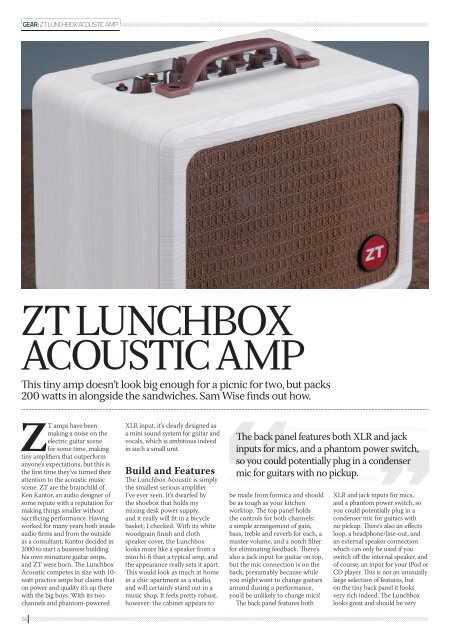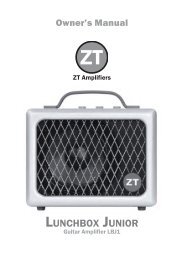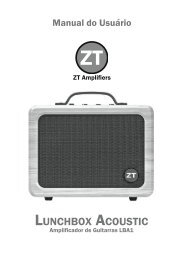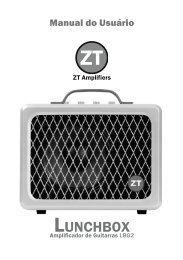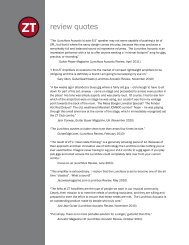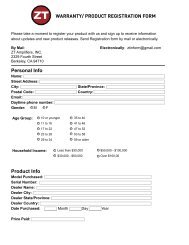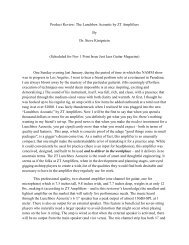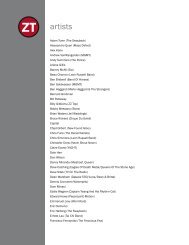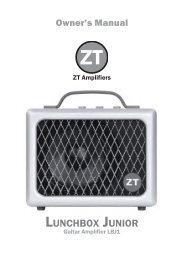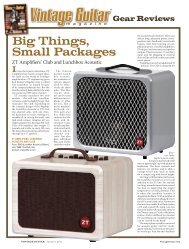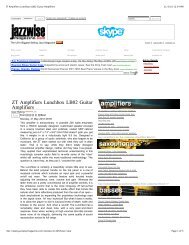zt lunchbox acoustic amp - ZT Amplifiers
zt lunchbox acoustic amp - ZT Amplifiers
zt lunchbox acoustic amp - ZT Amplifiers
- No tags were found...
Create successful ePaper yourself
Turn your PDF publications into a flip-book with our unique Google optimized e-Paper software.
GEAR: <strong>ZT</strong> LUNCHBOX ACOUSTIC AMP<strong>ZT</strong> LUNCHBOXACOUSTIC AMPThis tiny <strong>amp</strong> doesn’t look big enough for a picnic for two, but packs200 watts in alongside the sandwiches. Sam Wise finds out how.<strong>ZT</strong> <strong>amp</strong>s have beenmaking a noise on theelectric guitar scenefor some time, makingtiny <strong>amp</strong>lifiers that outperformanyone’s expectations, but this isthe first time they’ve turned theirattention to the <strong>acoustic</strong> musicscene. <strong>ZT</strong> are the brainchild ofKen Kantor, an audio designer ofsome repute with a reputation formaking things smaller withoutsacrificing performance. Havingworked for many years both insideaudio firms and from the outsideas a consultant, Kantor decided in2000 to start a business buildinghis own miniature guitar <strong>amp</strong>s,and <strong>ZT</strong> were born. The LunchboxAcoustic competes in size with 10-watt practice <strong>amp</strong>s but claims thaton power and quality it’s up therewith the big boys. With its twochannels and phantom-powered64XLR input, it’s clearly designed asa mini sound system for guitar andvocals, which is ambitious indeedin such a small unit.Build and FeaturesThe Lunchbox Acoustic is simplythe smallest serious <strong>amp</strong>lifierI’ve ever seen. It’s dwarfed bythe shoebox that holds mymixing desk power supply,and it really will fit in a bicyclebasket; I checked. With its whitewoodgrain finish and clothspeaker cover, the Lunchboxlooks more like a speaker from amini hi-fi than a typical <strong>amp</strong>, andthe appearance really sets it apart.This would look as much at homein a chic apartment as a studio,and will certainly stand out in amusic shop. It feels pretty robust,however: the cabinet appears toThe back panel features both XLR and jackinputs for mics, and a phantom power switch,so you could potentially plug in a condensermic for guitars with no pickup.be made from formica and shouldbe as tough as your kitchenworktop. The top panel holdsthe controls for both channels:a simple arrangement of gain,bass, treble and reverb for each, amaster volume, and a notch filterfor eliminating feedback. There’salso a jack input for guitar on top,but the mic connection is on theback, presumably because whileyou might want to change guitarsaround during a performance,you’d be unlikely to change mics!The back panel features bothXLR and jack inputs for mics,and a phantom power switch, soyou could potentially plug in acondenser mic for guitars withno pickup. There’s also an effectsloop, a headphone/line-out, andan external speaker connectionwhich can only be used if youswitch off the internal speaker, andof course, an input for your iPod orCD player. This is not an unusuallylarge selection of features, buton the tiny back panel it looksvery rich indeed. The Lunchboxlooks great and should be very
GEAR: <strong>ZT</strong> LUNCHBOX ACOUSTIC AMP<strong>ZT</strong> LUNCHBOXAcoustic Ampwww.<strong>acoustic</strong>magazine.com for reviewsTechnicalspecificationrugged. I have only two concerns:the first is that after six monthskicking around the back of yourcar, the lovely white formica willbe showing the dirt rather morethan your average black vinyl. Theonly other is the miniature toggleswitch to select internal or externalspeaker, which looks as though itcould be vulnerable in the hurlyburlyof life in the back of a van (orSmart car, in this case).Price: £389Made In: USAPower: 200-watt 2-channel <strong>amp</strong>Speaker: 6.5” SpeakerInputs: 1 XLR/Line level input, 1 xguitar input, Aux in (for CD/MP3)Outputs: Two outputsEQ: 2-band EQEffects: Digital reverb, effects loopContactdetailsAria UKTel: 01483 238720www.ariauk.comWhatwe thinkSounds andUsabilityPracticality is definitely a strongpoint of the Lunchbox; let’s faceit, it would almost fit in the frontpocket of your gig bag. It’s easy tocarry, easy to find space for, andabout the right height to rest yourfoot on, if you are so inclined. Thecontrol layout of the top panel isextremely easy to understand, andthe black-on-silver print should beeasy to see even on a dark stage.The big question in most people’sminds will be whether such asmall <strong>amp</strong> can really produce thegoods sonically, however. Historyhas taught musicians that largeris better, sound quality-wise, andthe <strong>ZT</strong> challenges that perceptionhead-on. Plugging in, I was pleasedto discover a very nice, transparenttone; it simply sounded like myguitar, but louder. I always miss amid control in an EQ, and this wasno exception, but the core tonewas so good that it wasn’t an issue.If your guitar has a pickup whichrequires extreme EQ to soundgood, the lack of an ability to boostor cut the mid could hurt, but ifyour pickup system is good to startwith, you’ll have no problem withthe Lunchbox.Certainly, the EQ and volumesection is very intuitive and easyto use, and it was hard to go farwrong. The notch filter, designedto cut the frequencies thatgenerate feedback, is unusual inthat it has three positions. Mostnotch filters allow you to sweeparound the frequency range till youfind the troublesome spot, so howgood an effect you can really getfrom three fixed positions is trickyto judge. The reverb is really theonly effect you need on an <strong>acoustic</strong><strong>amp</strong>; most of us use nothing else,and if you are one of those whoprefer effects, the chances are youuse an outboard device anyway.The reverb works well, and for allthat it’s limited to a single sound,the payback is in the simplicity.It’s impressive, too, just how thesound holds up as you crank upthe volume: whether it’s vocals orguitar, it doesn’t sound boxy andit doesn’t distort. Where I do havea beef, however, is with the claimof 200 watts. Now, I know thatwattage doesn’t translate directlyto volume, but whereas my 200-watt bass <strong>amp</strong> will shake the wallswithout breaking a sweat, theLunchbox doesn’t seem any louderthan my existing 60-watt <strong>amp</strong>.I’ll admit that I didn’t get it up to10, due to feedback issues, butthere wasn’t much further to go.This is not necessarily a problem:the Lunchbox is <strong>amp</strong>ly loud forsmall club gigs, but the 200 wattsis misleading.ConclusionPut simply, there is no moreportable solution for a singer/guitarist than this. With a shoulderbag you can walk to your gigs, ortake the bus, or even cycle (somebands like the Ginger Ninjas arenow touring by bicycle!). It’ll alsotake up very little space if youlive in a small flat, and just asimportantly, it sounds great and iswell built. It’s cheaper than manynice 60-watt combos, and it lookslike no other <strong>amp</strong> into the bargain.The only black mark is that itdoesn’t sound three times as loudas a 60-watter, but if you’re lookingfor a small <strong>amp</strong>, you simply musttry this out.Sam WisePros: Sounds good, looks good, wellpriced and tiny.Cons: Not as loud as 200 wattswould have you imagine, speakerswitch could be vulnerable.Overall: Knocks the competition forsix. If you need a small <strong>amp</strong>, try one.Our Ratings Explained5 Stars: Superb, Almost faultless.4 Stars: Excellent, Hard to beat.3 Stars: Good, covers all bases well.2 or 1 Stars: Below average, poor.Ratingout of fiveBUILD QUALITYSOUND QUALITYVALUE FOR MONEY65


